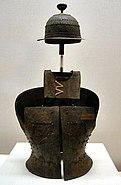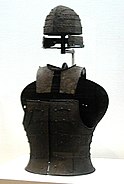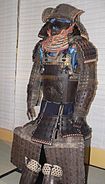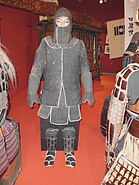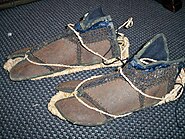
A samurai on horseback wearing (ō-yoroi)
Armour in Japan has a history that goes back as far as the 4th century.[1] Japanese armour developed enormously over the centuries since its introduction to the battlefield. It was worn to varying degrees by numerous classes; most notably by the samurai (and by default the ashigaru), and was seen on the battlefield both on mounted and foot troops. The pinnacle of Japanese lamellar armour is generally accepted as being the ō-yoroi (大鎧, literally 'great armour') type.
History[]

Antique samurai ō-yoroi armour from the Met museum.
Japanese armour is thought to have evolved from the armour used in ancient China and Korea.[1] Cuirasses and helmets were manufactured in Japan as early as the 4th century.[2]Tankō, worn by foot soldiers and keikō, worn by horsemen were both pre-samurai types of early Japanese cuirass constructed from iron plates connected together by leather thongs.
During the Heian period 794 to 1185 the Japanese cuirass evolved into the more familiar style of armour worn by the samurai known as the dou or dō. Japanese armour makers started to use leather (nerigawa) and lacquer was used to weather proof the armor parts. By the end of the Heian period the Japanese cuirass had arrived at the shape recognized as being distinctly samurai. Leather and or iron scales were used to construct samurai armours, with leather and eventually silk lace used to connect the individual scales (kozane) which these cuirasses were now being made from.[3]
In the 16th century Japan began trading with Europe during what would become known as the Nanban trade. Samurai acquired European armour including the cuirass and comb morion which they modified and combined with domestic armour as it provided better protection from the newly introduced matchlock muskets known as Tanegashima. The introduction of the tanegashima by the Portuguese in 1543[4] changed the nature of warfare in Japan causing the Japanese armour makers to change the design of their armours from the centuries old lamellar armours to plate armour constructed from iron and steel plates which was called tosei gusoku (new armours).[5] Bullet resistant armours were developed called tameshi gusoku or (bullet tested)[6] allowing samurai to continue wearing their armour despite the use of firearms.
The era of warfare called the Sengoku period ended around 1600, Japan was united and entered the peaceful Edo period, samurai continued to use both plate and lamellar armour as a symbol of their status but traditional armours were no longer necessary for battles. During the Edo period light weight, portable and secret hidden armours became popular as there was still a need for personal protection. Civil strife, duels, assassinations, peasant revolts required the use of armours such as the kusari katabira (chain armour jacket) and armoured sleeves as well as other types of armour which could be worn under ordinary clothing.[7] Edo period samurai were in charge of internal security and would wear various types of kusari gusoku (chain armour) and shin and arm protection as well as forehead protectors (hachi-gane).[8]
Armour continued to be worn and used in Japan until the end of the samurai era (Meiji period) in the 1860s, with the last use of samurai armour happening in 1877 during the Satsuma Rebellion.[9]

Nanban dou (dō) gusoku, a Japanese (samurai) suit of armour with a western-style cuirass (dou or dō) made of plate armour. Tokyo National Museum.
Construction[]

Construction of samurai armour, Source Wendelin Boeheim Leipzig 1890:
1. Cuirass - dou or dō (胴(仏胴))
2. Fauld - kusazuri (草摺)
3. Cuisse - haidate (佩楯)
4. Poleyn - tateage (立挙)
5. Greaves - suneate (臑当(篠臑当))
6. Sabaton - kōgake (甲懸)
7. Spaulders - sode (袖(当世袖))
8. Vambrace - kote (籠手(篠籠手))
9. Gauntlets - tekkō (手甲(摘手甲))
10. Helm - kabuto (兜(日根野形頭形兜))
11. Badge (helmet) - kasa-jirushi (腰巻)
12. Forehead plate - mabisashi (眉庇)
13. Lame - fukikaeshi (吹返)
14. Neck guard - shikoro (しころ(日根野しころ))
15. Crest (here: water buffalo horns) - wakidate (立物(水牛の脇立))
16. Crest (here: sun disk) - maedate (立物(日輪の前立))
17. Faceplate - menpō or mempō (面頬(目の下頬))
18. Badge (shoulder) - sode-jirushi (垂)
19. Bevor - yodare-kake (襟廻)
Japanese armour was generally constructed from many small iron (tetsu) and or leather (nerigawa) scales (kozane) and or plates (ita-mono), connected to each other by rivets and lace (odoshi) made from leather and or silk, and or chain armour (kusari). These armor plates were usually attached to a cloth or leather backing. Japanese armour was designed to be as lightweight as possible as the samurai had many tasks including riding a horse and archery in addition to swordsmanship. The armour was usually brightly lacquered to protect against the harsh Japanese climate. Chain armour (kusari) was also used to construct individual armour pieces and full suits of kusari were even used.[10]
Individual armour parts[]
A full suit of traditional Samurai armour could include the following items:
- Dou or dō, a chest armour made up of iron and or leather plates of various sizes and shapes with pendents
- kusazuri made from iron or leather plates hanging from the front and back of the dou (dō) to protect the lower body and upper leg.
- Sode, large rectangular shoulder protection made from iron and or leather plates.
- Kote, armoured glove like sleeves which extended to the shoulder or han kote (kote gauntlets) which covered the forearms. Kote were made from cloth covered with iron plates of various size and shape, connected by chain armor (kusari).
- Kabuto, a helmet made from iron or leather plates (from 3 to over 100 plates) riveted together. A neck guard shikoro made from several layers of curved iron or leather strips was suspended from the bottom edge of the kabuto.
- Mengu, various types of lacquered metal and or leather facial armour designed in a way that the top heavy helmet kabuto could be tied and secured to them by various metal posts. Mengu had throat guards yodare-kake made from several rows of iron or leather plates or kusari (chain armour) sewn to a cloth backing, suspended from the bottom edge.
- Haidate, thigh guards which tied around the waist and covered the thighs. These were made from cloth with small iron and or leather plates of various size and shape, usually connected to each other by chain armour (kusari) and sewn to the cloth.
- Suneate, shin guards made from iron splints connected together by chain armor (kusari) and sewn to cloth and tied around the calf.
Auxiliary armours[]
- Guruwa, a type of throat and neck protector.
- Nodowa, a type of throat and neck guard.
- Tate-eri, the tate-eri is a small padded pillow like piece with a standing armored collar that sits on the shoulder to protect from the weight of the dou (dō). The standing collar would be lined with kikko armor to protect the neck.
- Manju no wa, the manju no wa, ( also manjunowa or manju nowa ) is a combination of shoulder pads, collar and armpit guards in one that protected the upper chest area. Manju no wa were covered with kusari (chain armor), karuta (small armor plates), or kikko (brigandine), these armors or a combination of them were sewn to a cloth backing. The armor could be exposed or hidden between a layer of cloth. When worn the manju no wa looked like a small tight fitting vest. Manju no wa have small wings that would pass under the arm pit area from the back and attach to the front of the manju no wa.
- Manchira, the manchira is a type of armored vest covered with kusari (chain armor), karuta (small armor plates) or kikko (brigandine), these armors or a combination of them were sewn to a cloth backing. The armor could be exposed or hidden between a layer of cloth. Manchira are larger than manju no wa and protected the chest area and sometimes the neck and arm pit. Some manchira could be worn over the dou (dō).
- Wakibiki, the wakibiki is a simple rectangle of cloth covered with kusari (chain armor), karuta (small iron plates), or kikko (brigandine) these armors or a combination of them were sewn to the cloth backing. Wakibiki could also be made from one solid piece of iron or hardened leather. The wakibiki had cords connected to them which allowed the wakibiki to hang from the shoulder, the wakibiki was then suspended over the exposed arm pit area. Wakibiki were worn inside the of the chest armour dou (dō) or on the outside depending on the type.
- Armoured zukin, cloth hoods with various types of armour sewn to the cloth.
- Kogake, armored tabi, a kind of sabaton that covered the top of the foot.
- Jingasa (war hat), resembling the civilian coolie hat, issued to Ashigaru retainers, these could be made from metal or leather.
- Hachi gane/hitai ate, various types of light weight, portable, forehead protectors.
- Katabira, jackets covered with various types of armour, the armour could be exposed or hidden between layers of cloth.
Clothing worn with Japanese armour[]
- Uwa-obi or himo, a cloth sash or belt used for attaching various weapons and other items such as the katana, wakizashi and tantō.
- Fundoshi, a simple loin cloth.
- Kyahan or kiahan, tight gaiters made of cloth which covered the shins.
- Hakama, a type of pants worn underneath the armour, hakama could be long or short like the kobakama.
- Shitagi, a shirt worn underneath the armour.
- Tabi, a cloth sock with divided toes.
- Waraji, a woven sandal also known as zōri.
- Kutsu, short riding boots made from leather.
- Yugake, gloves that were worn under the kote.
- Kegutsu, also known as tsuranuki, short leather shoes trimmed with bear fur.
Auxiliary items worn with Japanese armour[]
- Sashimono, a small banner that is attached to the back of the dou (dō) by special fittings. Its purpose was to identify the wearer as friend or foe which was essential in the chaotic confusion of a pitched battle melee.
- Horo - A cloak reserved for prestigious, high-ranking samurai. It provides additional protection from arrows.
- Agemaki, a decorative tassel worn on the back of some dou and kabuto, the agemaki can also serve as an attachment point.
- Jirushi, small identification flags or badges worn on the back of the helmet (kasa jirushi) or on the shoulder (sode jurishi).
- Datemono/tatemono, crests of various shapes and sizes worn on several areas of the helmet (kabuto).
- Yebira arrow quiver for ya (arrows).
In popular culture[]
- The villain of Star Wars, Darth Vader wears futuristic armour including a helmet that bears a striking resemblance to the kabuto.
- When Hannibal Lector seeks revenge on the Nazis who killed his sister, he disguises himself with a mask from his aunt's ancestral armor.
- The Shredder, villain of the Teenage Mutant Ninja Turtles movies, wears a full suit of samurai armor with razor-sharp spikes.
- Samurai armor is also worn by characters in Japanese martial arts films and samurai films like Yojimbo, the Seven Samurai, Shogun Assassin, and by Tom Cruise in the Last Samurai.
Types[]
Pre-samurai armour[]
- Armours that were worn in Japan before the samurai class evolved.
- Tanko
- Keiko
Kozane armour[]
Kozane dou (dō) gusoku, are samurai armours with a lamellar cuirass constructed from individual scales (kozane), old fashioned armours used before the introduction of firearms in Japanese warfare, (pre-Sengoku styles)[11][12]
- O-yoroi, old style dou (dō) for mounted samurai, constructed with hon kozane (small individual scales).
- Dō-maru, old style dou (dō) constructed with hon kozane (small individual scales).
- Haramaki dou (dō), old style dou (dō) that opened in the back, constructed with hon kozane (small individual scales), later period haramaki dou (dō) were made with armour plates.
- Hon kozane dou (dō) (small individual scales)
- Hon-iyozane dou (dō) or Nuinobe dou (dō) (large individual scales).
Tosei-gusoku[]
Tosei dou (dō) gusoku the so-called "modern armours" made from iron plates (ita-mono)[13] instead of individual scales (kozane). Tosei-gusoku became prominent starting in the 1500s due to the advent of fire arms, new fighting tactics and the need for additional protection.[14][15]
- Okegawa Dou (dō) guskou - (tub-sided), refers to the tub-like shape of the dou (dō). There are two types of okegawa dou (dō): yokohagi (horizontal lames), and tatehagi (vertical lames).
- Hishinui dou (dō) or Hishi-toji dou (dō) - chest armours with rows of prominent cross knots, usually an okegawa dou (dō).
- Munemenui dou (dō) or Unamenui dou (dō) - chest armours with a running stitch that goes horizontally across the surface of the dou (dō). This stitch of lacing runs along the surface of the lame looking like a dotted line paralleling the top.
- Dangae dou (dō) gusoku - meaning "step-changing", a combination of two or more styles.
- Hotoke dou (dō) gusoku - chest armor which is smooth and shows no signs of lames.
- Nio dou (dō) - embossed to resemble the emaciated torso of a starving monk or old man.
- Katahada-nugi dou (dō) - embossed to resemble a half-naked torso.
- Yukinoshita or Sendai dou (dō) - A five plate, four hinge (go-mai) chest armor in the sendai or yukinoshita style.
- Hatomune dou (dō) gusoku - (pigeon-breast chest armour or cuirass) were inspired by European peascod breastplate armour. Hatomune dou (dō) have a sharp central ridge running vertically down the front.
- Uchidashi dou (dō) gusoku - Embossed or hammered out relief on the front.
- Nanban dou (dō) gusoku — Armour made on the base of late European armour
- Mōgami dou (dō) - five-plate, four hinge (go mai) chest armours with solid lames which are laced with sugake odoshi instead of being riveted.
Other types[]
- Tatami-gusoku — Folding portable armour made from karuta armour (small square or rectangular plates)or kikko armour (small hexagon plates).[16][17] Kusari gusoku (chain armour) is another form of tatami armour. Chochin kabuto (collapsible helmets) and hachi gane ( forehead protectors) that folded were also tatami armour.
- Tameshi-gusoku — bullet tested armour
- Okasi-gusoku — lending or borrowing armour or munition armour, usually made for ashigaru (it might be Tatami-do or any plain basic armour) often marked with clan insignia (mon).
- Uma yoroi, horse armour used in the Edo period for parades.
- Kusari gusoku Chain armour, armour made entirely of or the majority of the armour being made from kusari (chain mail) sewn to cloth.[18]
- Kigote, a general term for several varieties of kote extended or completed by the addition of erisuwari (padded collar), kara-ate (shoulder pads) and wakibiki (armpit protectors). Examples of the kigote are the kote haramaki (kote which covers the belly), tominaga kote (kote that connect to each other in the front and back), sashinuki kote (kote made in the form of a short jacket).
- Katabira, armored jackets of various styles and sizes. Katabira were armored with kikko, hexagon armor plates, karuta, square or rectangular armor plates, or kusari, chain armor, or a combination of these armors.
Individual samurai armor parts[]
See also[]
- Lamellar armour
- Laminar armour
- Plated mail (tatami-do only)
- Shar-ayne — middle east armour which has similar construction as the Sendai or yukinoshita dou (dō)
- Kusari (Japanese mail armour)
- Kikko (Japanese armour)
- Karuta (Japanese armour)
- Wakibiki
- Kabuto
- O-yoroi
- Dō (armour)
- Suneate
- Tatami-dō
References[]
- ↑ 1.0 1.1 Sacred texts and buried treasures: issues in the historical archaeology of ancient Japan (Google eBook), William Wayne Farris, University of Hawaii Press, 1998 P.75
- ↑ Sacred texts and buried treasures: issues in the historical archaeology of ancient Japan, William Wayne Farris, University of Hawaii Press, 1998 P.75
- ↑ Oriental Armour, H. Russell Robinson, Courier Dover Publications, 2002 P.i73
- ↑ Tanegashima: the arrival of Europe in Japan, Olof G. Lidin, Nordic Institute of Asian Studies, NIAS Press, 2002
- ↑ Samurai: The Weapons and Spirit of the Japanese Warrior, Clive Sinclaire, Globe Pequot, 2004 P.32
- ↑ The Watanabe Art Museum Samurai Armour CollectionVolume I ~ Kabuto & Mengu, Trevor Absolon P.78
- ↑ Secrets of the samurai: a survey of the martial arts of feudal Japan, Oscar Ratti, Adele Westbrook, Tuttle Publishing, 1991 P.196
- ↑ Taiho-jutsu: law and order in the age of the samurai, Don Cunningham, Tuttle Publishing, 2004 P.46
- ↑ Samurai: The Weapons and Spirit of the Japanese Warrior, Clive Sinclaire, Globe Pequot, 2004 P.58
- ↑ George Cameron Stone (2 July 1999). A Glossary of the Construction, Decoration and Use of Arms and Armor: In All Countries and in All Times. Courier Dover Publications. p. 61. ISBN 978-0-486-40726-5. http://books.google.com/books?id=J5PgapzD6FoC&pg=PA61. Retrieved 18 February 2011.
- ↑ Japan's ancient armour, Hatiro Yamagami, Japan. Kokusai Kankōkyoku, Board of Tourist Industry, Japanese Government Railways, 1940
- ↑ Japan's ancient armour, Hatiro Yamagami, Japan. Kokusai Kankōkyoku, Board of Tourist Industry, Japanese Government Railways, 1940
- ↑ Oriental Armour, H. Russell Robinson, Courier Dover Publications, 2002 p.190
- ↑ Samurai: The Weapons and Spirit of the Japanese Warrior, Clive Sinclaire, Globe Pequot, 2004, p.32
- ↑ Samurai: The Weapons and Spirit of the Japanese Warrior, Clive Sinclaire, Globe Pequot, 2004, p.171
- ↑ A glossary of the construction, decoration, and use of arms and armor by George Cameron, p.61
- ↑ Ian Bottomley & A.P. Hopson "Arms and Armor of the Samurai: The History of Weaponry in Ancient Japan" pp.88, 91
- ↑ A glossary of the construction, decoration, and use of arms and armor by George Cameron, p.61
External links[]
| Wikimedia Commons has media related to Samurai armour. |
- Anthony Bryant's online Japanese armour manual
- "The Samurai Archives" Japanese history site and forum
- Shogun Samurai reenactment group
- Trevor Absolon's Samurai armour collectors forum.
- Glossary of Japanese armor terms.
| |||||||||||||||||||||||||||||||||||||||||||||||
The original article can be found at Japanese armour and the edit history here.
